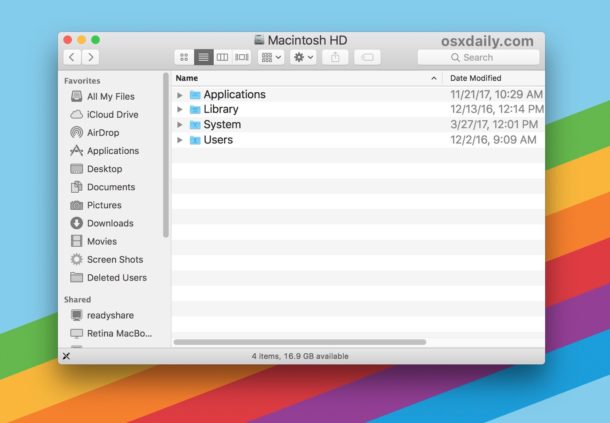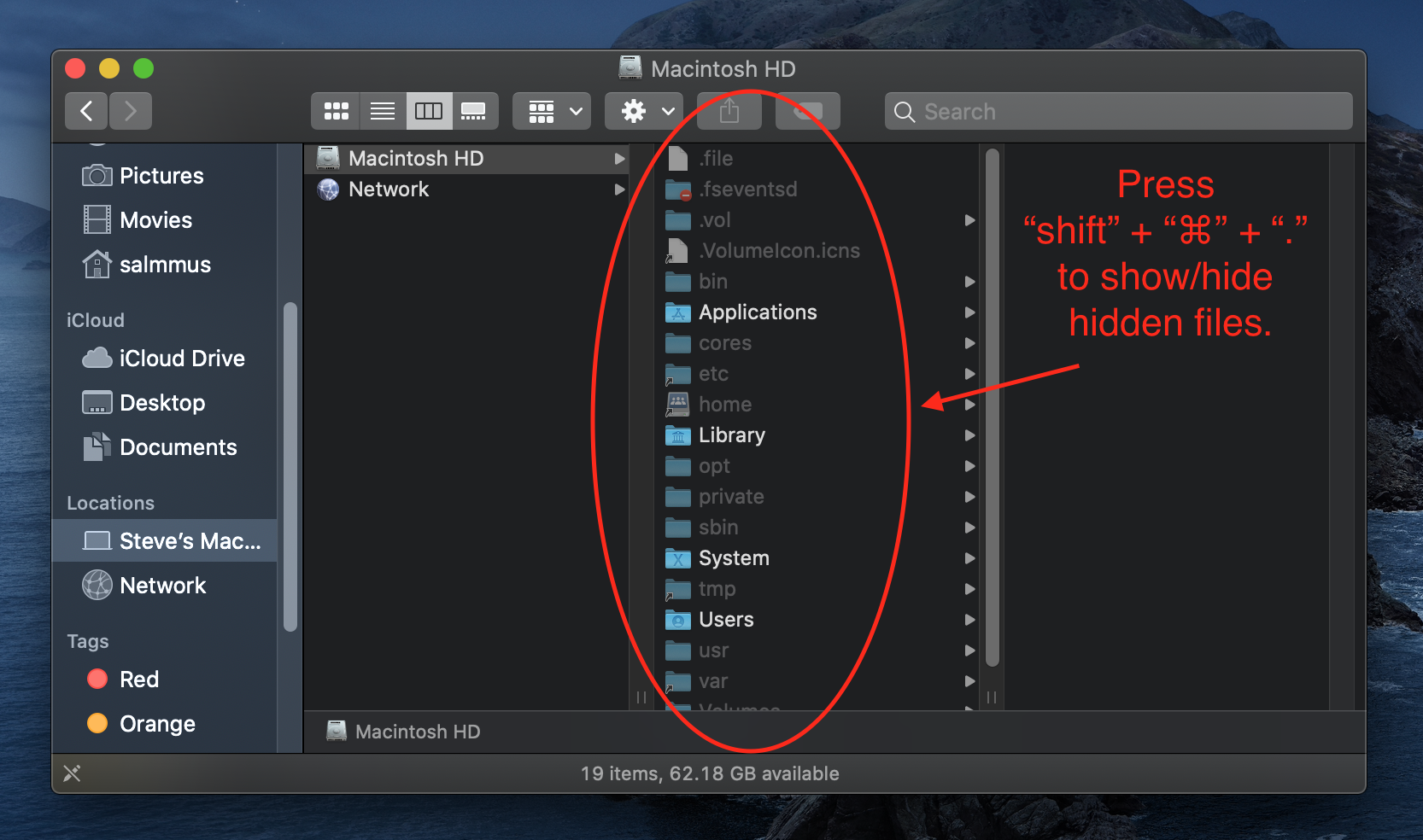Table of Contents
PC running slow?
Over the past few days, some readers have come across an error message regarding OS x hidden system files. This problem can arise for several reasons. Let’s discuss some of them below. Using any mouse, drag the specific files or folders you want to hide into the terminal window. The file location is displayed throughout the window.Press Enter to hide certain files.
PC running slow?
ASR Pro is the ultimate solution for your PC repair needs! Not only does it swiftly and safely diagnose and repair various Windows issues, but it also increases system performance, optimizes memory, improves security and fine tunes your PC for maximum reliability. So why wait? Get started today!

This article shows you how to show these hidden files as files and the easiest way to hide them again.
How To Directly Show Hidden Files In MacOS
How do I hide system files?
To hide a file folder in Windows, open a Windows Explorer or Explorer window and locate the file or folder you want to hide. Right-click it and select Properties. Select the Hidden Type check box in the General area assigned to the Properties window. Click OK or Apply and your file or folder will be hidden.
To view hidden files on Mac, use the Terminal app .
-
Open the Terminal application. You can do this by opening Spotlight and entering the word “terminal” in the search box. You can also open Terminal from a Finder window and / or go to Applications> Utilities> Terminal.
-
Enter the following command at the terminal prompt:
The default is com.apple.finder AppleShowAllFiles -boolean true killall Finder Otherwise, if you are using OS X 10.8 or earlier, enter this command:
defaults com write.apple.finder AppleShowAllFiles TRUE: killall Finder
Two command lines allow you to achieve your goals. The first part changes the file parameter if you want to show hidden files. The second part re-launches Finder to display the files.
How do I hide ghost files on Mac?
Open terminal.Enter: hidden chflags [press space]Drag and drop deleted files or folders from Finder into the terminal window, the paths to which will be permanently displayed in the terminal.Click Back to hide.
In most cases, you want these hidden files and folders out of sight. Indeed, there are circumstances in which you would like you to see them. For example, malware and viruses can cause problems when system files are changed and renamed and important folders. In such cases, be sure to manually reset these files, and so will you if they are almost always invisible.
Remember that there are many input and output files and folders. If you show a hidden version and view files in a Finder window, the location of the files in the list will be completely different.
How To Hide Files On MacOS

When you’re done with some hidden files and folders, it is practically a good idea to revert those files back to their hidden state.
-
How do I permanently hide hidden files on Mac?
Hold down Command, Shift, and Period: cmd + Shift + [.] Hidden files and folders on your Mac will become partially transparent. You can hide files again using the real keyboard shortcut.
Open the Terminal application. You can do this by opening Spotlight and typing Terminal in the search box, or by opening an Absolute Finder window and going to Applications> Utilities> Terminal.
-
In a terminal, enter the following command at the command prompt:
The default values are provided by com.apple.finder AppleShowAllFiles -boolean false; Killall Finder If you are using OS X 10.8 or are typing fast, use this command instead:
The default is com.apple.finder AppleShowAllFiles FALSE; Killall Finder
If you cancel the hidden file detection process, the files will be returned to their hidden state and Finder will re It will run to successfully reflect the change.
A Few Words About The Terminal Application
Using the terminal should be the same as looking outside the windows, then the GUI menus you are used to will help you. When you open an app, format a new USB drive, or browse your computer with Spotlight, you’re basically running terminal commands. the difference is that the codes are assigned automatically and are artistically represented, making them very user-friendly.
What You Need To Know
- In time, enter com by default at the terminal prompt. write.apple.finder AppleShowAllFiles – Boolean True Killall; Seeker.
- macOS hides important system files and versions to prevent accidental changes during uninstallation.
The information in this article applies to Macs running macOS Catalina (10.15) through OS X Lion (10.7).
Most hidden files are operating system and files. They cannot be deleted or changed. You can be absolutely confident in what most people are doing.
There are many good reasons why you might want to hide some of your information or records. Maybe you are taking an absolute laptop with you and just want to automatically increase your security. You may be sharing your salary with others and you need to keep a lot of things a secret. Whatever the reason, there are always eight ways to do this in OS X.
1: Activate FileVault
This is probably the most obvious way. Go to the Security & Privacy Settings section and switch to FileVault. This will completely encrypt your hard drive, so someone will need a password to access the content.
2: Hide Them In The Library
Assuming your / Library file is hidden (this is the default in OS X Mountain Lion), hold down the Option key while opening the Finder Go menu. Go to that library folder and then create a new folder there where you need to drag the files or folders you want to hide there.
3: Add Them To Another User Account
Create a new user with enabled user and group settings inSystem Preferences, then put the files and folders you want to hide under this account.

Enter chflags hidden into the terminal, then drag any folder or file you want to hide into the terminal window; You can access hidden folders and files today by going to the Go to Folder discussion (Command-Shift-G) and entering their full paths. To display them, return to the terminal and also enter chflags nohidden followed by the full path or folder. Make
5: Secret File / Folder 2
Enter mv filename .filename again in the terminal. This will move the original folder to the dot with a period at the beginning of its name; By default, folders with occurrences at the beginning of their names are typical hidden operating systems in X. You can also enter mkdir .hiddenfolder to create a new hidden folder. Either way, you should be able to access the hidden folder again using the Go to Folder option.
6: Hide In Plain Sight
Use innocent sounding filenames as such chat segments January 2013 - LOL! instead of something fun ( Top Secret ).
7: Set Visibility Attribute To Invisible
If you have Apple Tools Developer installed, go to terminal and type setfile - new V followed by the name of the user file or folder. This sets its ranking attribute to invisible; You can undo this type of repetition with the command with your own lowercase v .
8. Use A Third Party Solution
So this article: Eight Different Ways Files Can Hide Folders in OS X. Thanks to freelance writer Steve McCabe for the tips. You can find them and more in the April issue of Macworld under 100 Floors More Things Every Mac User Should Know.
Improve the speed of your computer today by downloading this software - it will fix your PC problems. Etapas Para Recuperar Arquivos Ocultos Do Sistema OS X
Kroki Odzyskiwania Ukrytych Plików Systemowych OS X
Schritte Zum Wiederherstellen Versteckter OS X-Systemdateien
숨겨진 OS X 시스템 파일을 복구하는 단계
Étapes Pour Récupérer Les Fichiers Système OS X Cachés
Действия по восстановлению скрытых системных файлов OS X
Steg För Att återställa Dolda OS X-systemfiler
Pasos Para Recuperar Archivos De Sistema OS X Ocultos
Passaggi Per Recuperare I File Di Sistema OS X Nascosti
Stappen Om Verborgen OS X-systeembestanden Te Herstellen